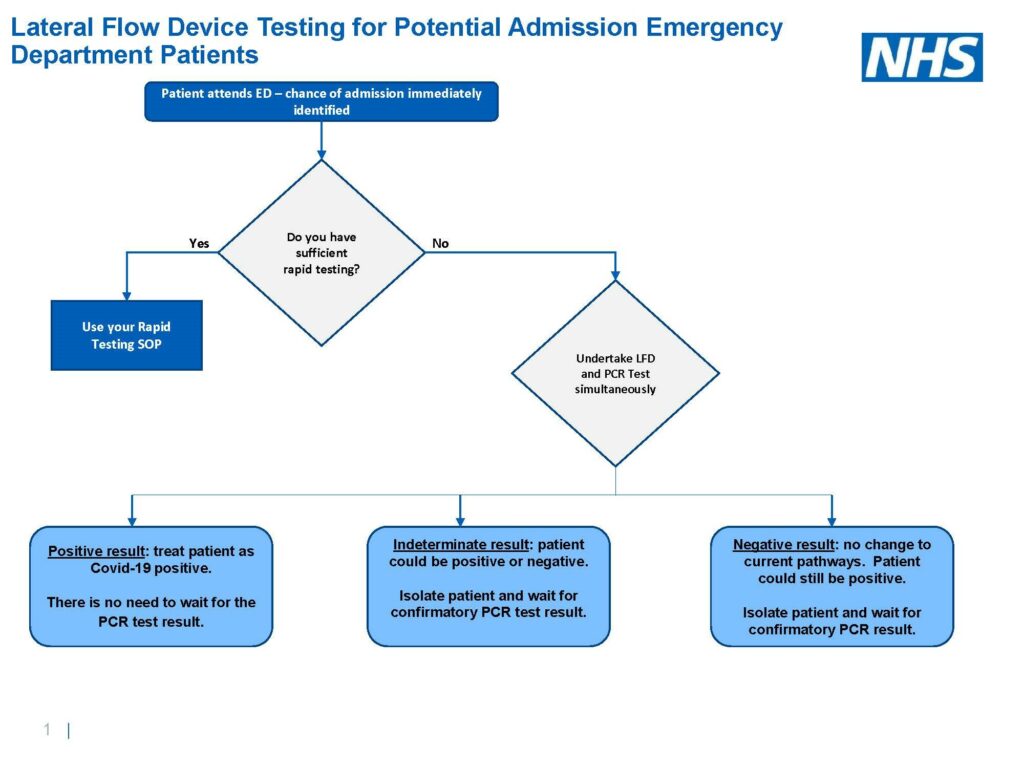Standard operating procedure: Lateral flow device testing for emergency department patient pathways
Contents
- Overall aim
- Objectives
- Context
- Implementation
- Reporting results
- Review of risks and mitigation
- Switching to a different device
Classification: Official
Publications approval reference: C0999
24 December 2020 Version 1
Overall aim
To roll out rapid testing to emergency admission (via ED) patients using Lateral Flow Assay devices (LFD) on nasal swab samples with immediate effect where other forms of rapid testing are not available. This will enable fast tracking of COVID-19 positive patients admitted via the emergency department (ED) pathway and the reduction of the risk of nosocomial transmission.
Objectives
- To support the NHS in its infection control risk reduction strategy
- To support EDs to access prompt test results for COVID-19 positive patients
- To support COVID-19 positive clinical pathways over the winter period
Context
The LFD gives a rapid result (15-30 minutes depending on the assay), has good specificity but is less sensitive than PCR tests. LFD testing will be used to supplement mandatory PCR testing, which typically takes several hours from swab taken to test result. The approach is to respond to positive LFD results only. LFD testing will not replace obligatory PCR testing.
Implementation
Use of LFD should be introduced for patients entering the ED with a possibility of admission and where COVID-19 positive clinical pathways are impacted due to other rapid testing solutions not being immediately available. The supply of lateral flow tests currently in trusts should be prioritised for patient facing staff testing; if spare devices are available, these can be used in ED for patients whilst supplies are being replenished.
A trained member of staff should conduct the LFD test and simultaneously conduct the PCR test, as soon as it is apparent that a patient entering the ED is likely to be admitted, and that another rapid testing option is not available.
Pathology networks should work with EDs to ensure quality assurance checks on batches of LFD are performed as they deem suitable.
Actions following LFD result:
- Positive: treat patient as COVID-19 positive. There is no need to wait for the PCR test result.
- Indeterminate: patient could be positive or negative. Isolate patient and wait for confirmatory PCR test result.
- Negative: no change to current pathways. Patient could still be positive, isolate patient and wait for confirmatory PCR result.
Reporting results
Every test result, positive and negative, should be logged by the department. The trust should then collate these results and submit them to Public Health England, using the same process as for maternity and staff testing (as required by law).
Lateral flow device testing for potential admission emergency department patients

Review of risks and mitigation
Test limitation
- Failure to follow the instructions for test procedure and interpretation of test results may adversely affect test performance and/or produce invalid results.
- A negative test result may occur if the specimen was collected or extracted improperly. A negative test result does not eliminate the possibility of COVID-19 infection
- Positive test results do not rule out co-infections with other pathogens.
- Lateral Flow Devices do not detect non-infectious virus during the later stages of viral shedding that might be detected by PCR molecular tests
These limitations will be mitigated as far as possible by the actions outlined in this document, particularly related to training, and by other nationally and locally available information on COVID-19 symptoms and actions that should be taken.
Transmission of COVID-19 to tester: using an LFD is not an aerosol generating procedure and should be done in a specified environment by trained staff wearing personal protective equipment (PPE).
Contamination of environment, eg sneezing after collecting sample or following any positive case, the clinical setting should be thoroughly cleaned to prevent cross contamination.
False negative: all PCR test results must be followed up.
False positive: all PCR test results must be followed up, even for patients who test positive on LFD.
Staff member assumes negative result is conclusive. Patient could still be positive, undertake confirmatory PCR test.
Insufficient availability of either rapid or LFD testing: priority should be given to using the LFD tests in patients with greater probability of COVID-19 infection. In this cohort, positive tests are more likely and more reliable.
Switching to a different device
Any switching to a different LFD will be carefully planned and managed with further training materials and written instructions prepared and distributed. Pathology networks should work with EDs to ensure quality and performance of devices prior to implementation.
